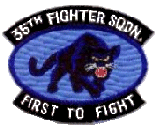by Richard Keyt
This area of KEYTLaw is devoted to the F-4 Phantom II supersonic fighter-bomber. I was fortunate to have flown the F-4 for five years in the United States Air Force. It was a wonderful experience that I would not trade for anything.
About the F-4
The F-4 Phantom II is a two-place supersonic, long-range, all-weather fighter-bomber built by the McDonnell Douglas Corporation. It’s top speed exceeds Mach 2.2, more than twice the speed of sound. The Phantom’s multi-role missions were air superiority, including long-range, high-altitude intercepts using air-to-air missiles as the primary armament and a 20mm gatling gun as the secondary armament; long-range attack missions using conventional or nuclear weapons as a primary armament; close air support missions using a choice of bombs, rockets and missiles as the primary armament; air defense suppression; fleet defense and reconnaissance.
The Phantom was first flown in 1958 and entered U.S. Navy service in 1961. The Air Force version debuted in 1963. It was also flown by the Marine Corp. The U.S. military retired the F-4 in 1996. Both the Air Force Thunderbirds and the Navy Blue Angels used the fighter for their demonstration teams. F-4s were also flown by the air forces of Australia, Egypt, Germany, Great Britain, Greece, Iran, Israel, Japan, South Korea, Spain and Turkey.
McDonnell Douglas produced Phantoms for 21 years from 1958 to 1979 during which it made 5,195 aircraft at its plant in St. Louis, Missouri. Mitsubishi Aircraft Company also constructed 138 Phantoms for the Japanese Self Defense Force. The U.S. Air Force received 2,874 F-4s, the Navy and Marine Corps received 1,264 and foreign purchasers received 919. More F-4s were built than any other supersonic jet fighter.
The Phantom was the premier fighter through out the world during its era. It was the work horse of the Vietnam war. People who flew the Phantom loved it. It is a fantastic airplane and a joy to fly.
Performance Characteristics
| Cruising speed | 585 mph |
| Maximum speed | Mach 2.2+ or greater than 1,500 mph |
| Initial climb rate | 61,400 feet per minute |
| Service ceiling | 62,250 |
| Combat range | 595 miles |
| Maximum range | 1,885 miles with three external fuel tanks |
Airplane Dimensions
| Wing span (wings spread) | 38 feet, 5 inches |
| Wing span (wings folded) | 27 feet, 7 inches |
| Length | 63 feet |
| Height | 16 feet, 5 inches |
| Gross weight | 31,500 pounds to 33,000 pounds |
| Maximum takeoff weight | 54,000 to 55,000 pounds |
Armament
The F-4E has a single 20-mm M61A1 six barrel cannon capable of firing at a rate of 6,000 rounds per minute. The gun was armed with 639 rounds and located under the nose of the aircraft. It carried four AIM-7 Sparrow semi-active radar homing air-to-air missiles in semi-recessed slots in the fuselage belly. In addition, the F-4 carried four AIM-9 Sidewinder infra-red homing air-to-air missiles under the wings on inboard armament pylons. The airplane can carry up to 16,000 pounds of bombs, including tactical nuclear weapons.
Engines
Aircraft thrust is provided by two axial-flow turbo jet engines with variable stators and variable afterburner. The airplane is powered by two General Electric J79-GE-17 engines. The engines are light-weight (approximately 4,000 pounds each) high thrust axial-flow turbojets equipped with afterburner for thrust augmentation. Under sea level, static test conditions, the engine is rated at 11,870 pounds thrust at Mil power, while at Max power it is rated at 17,900 pounds of thrust.
A Great Looking Machine
The USAF Technical Order 1F-4E-1 describes the F-4’s appearance as “characterized by a low mounted swept back wing with obvious anhedral at the wing tips, and a one piece stabilator with obvious cathedral.” I don’t know what that means, but to most people who flew it, the F-4 was the most beautiful fighter ever built. Some F-4 drivers affectionately called the Phantom “double ugly,” but I never believed they really meant it. It was also called “Rhino” and “Smoker” because of the thin trail of smoke left by the General Electric J79 engines.
Detailed Information About Phantoms
Joseph F. Baugher works at Lucent Technologies in Naperville, Illinois, as a software developer. He is an avid military aviation buff. Joe has written almost a complete history of all U.S. military aircraft since 1920. See Joe’s web site if you need information about U.S. military airplanes.
Joe Baugher’s F-4 Phantom website discusses every F-4 model in detail. It is the single best source of information about Phantoms.
